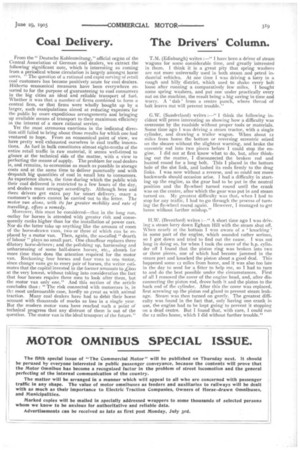Coal Delivery.
Page 15

If you've noticed an error in this article please click here to report it so we can fix it.
From the" Deutsche Kohlenzeitung," official organ of the Central Association of German coal dealers, we extract the following significant note, which is interesting as coming from a periodical whose circulation is largely amongst horse users. "The question of a rational and rapid serving of retail coal customers has become positively acute for coal dealers. Hitherto economical measures have been everywhere resorted to for the purpose of guaranteeing to coal consumers in the big cities an ideal and reliable transport of fuel. Whether it was that a numben of firms combined to form a central firm, or that firms were wholly bought up by a larger, such manipulations aimed at reducing expenses for the public by more expeditious arrangements and bringing up available means of transport to their maximum efficiency in the interest of a more rational service.
Yet the most strenuous exertions in the indicated direction still failed to bring about those results for which one had ventured to hope. From an economical point of view, we have pretty well exhausted ourselves in coal traffic innovations. As fuel in bulk constitutes almost eight-tenths of the entire retail traffic in raw material, it seems well-timed to glance at the technical side of the matter, with a view to perfecting the means of supply. The problem for coal dealers is, and remains, to economise as much as possible in storage costs and at the same time to deliver punctually and with despatch big quantities of coal in small lots to consumers. As experience shows, the time during which the public wish their coal delivered is restricted to a few hours of the day, and dealers must arrange accordingly. Although here and there drivers get extra pay for smart delivery, many a customer's orders cannot be carried out to the letter. The motor van alone, with its far greater mobility and rate of travelling, offers a remedy.
Moreover, this must be considered—that in the long run, outlay for horses is attended with greater risk and consequently ranks higher than for the installation of power cars. Nor do the latter take up anything like the amount of room of the horse-drawn vans, two or three of which can be replaced by a motor van. Then, again, the so-called "dearth of labour" plays no small part. One chauffeur replaces three dilatory horse-drivers; and the polishing up, harnessing and unharnessing of some half-dozen horses, etc., absorb far more time than does the attention required for the motor van. Reckoning four horses and four vans to one motor, since change vans go to every pair of horses, the writer estimates that the capital invested in the former amounts to £600 at the very lowest, without taking into consideration the fact that four horses require three men to look after them, but the motor van only one." And this section of the article concludes thus : "The risk connected with motorcars is, in the! most unfavourable case, hardly so great as with animal traction. Many coal dealers have had to debit their horse account with thousands of marks as loss in a single year. But the modern motor vans have reached such a point of technical progress that any distrust of them is out of the question. The motor van is the ideal transport of the future."
















